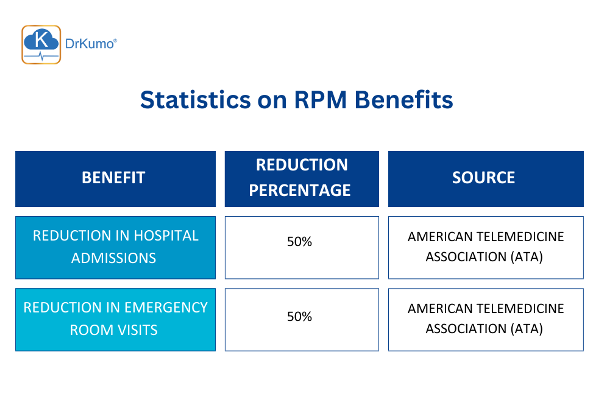Remote patient monitoring (RPM) significantly enhances the management of medications for individuals with chronic conditions. Additionally, Remote Patient Monitoring (RPM) reduces the frequency of in-person visits, making it easier for patients to receive consistent care and support.
According to the American Telemedicine Association (ATA), RPM can reduce hospital admissions by 50% and emergency room visits by 35%. By continuously tracking patients’ vital signs and health data, RPM enables healthcare providers to monitor medication adherence and effectiveness in real time. This proactive approach allows for timely adjustments to treatment plans, ensuring that medications are optimized for each patient’s specific needs. By improving disease management and personalizing health strategies, RPM plays a crucial role in enhancing overall patient outcomes and quality of life.
 The table illustrates the significant impact of RPM in reducing hospital admissions and emergency room visits. These findings emphasize the importance of RPM in continuously monitoring patients’ health, improving disease management, and personalizing health strategies to enhance overall patient outcomes and quality of life.
The table illustrates the significant impact of RPM in reducing hospital admissions and emergency room visits. These findings emphasize the importance of RPM in continuously monitoring patients’ health, improving disease management, and personalizing health strategies to enhance overall patient outcomes and quality of life.
This proactive approach allows for timely adjustments to treatment plans, ensuring that medications are optimized for each patient’s specific needs. Additionally, RPM reduces the frequency of in-person visits, making it easier for patients to receive consistent care and support. By improving disease management and personalized health strategies, RPM plays a crucial role in enhancing overall patient outcomes and quality of life.
Enhancing Medication Management
Remote patient monitoring significantly enhances medication management for chronic conditions. By providing continuous health data, it enables healthcare providers to make timely adjustments to treatment plans, ensuring medications are as effective as possible. For example, remote patient monitoring software can track vital signs and medication intake, alerting providers to any irregularities or missed doses. This proactive approach aids in patient management, ensures compliance with chronic condition protocols and health guidelines, and supports effective disease care. By maintaining protocol compliance and optimizing chronic disease care, remote patient monitoring helps prevent complications and improves patient outcomes.
Benefits of Remote Patient Monitoring
- Improved Disease Management: Remote patient monitoring facilitates better disease management by providing real-time data on patients’ health status. This allows for early detection of potential issues, leading to timely interventions and adjustments in medication or treatment plans.
- Personalized Health Management: With patient remote monitoring, healthcare providers can offer personalized health management plans tailored to individual needs. This customization is crucial for managing chronic conditions, where patient responses to treatments can vary widely.
- Efficient Patient Care: Remote patient monitoring streamlines patient care by reducing the need for frequent in-person visits. Patients can receive care and consultations from the comfort of their homes, making healthcare more accessible and convenient.
Challenges and Solutions
While remote patient monitoring offers numerous benefits, it also presents challenges. One significant challenge is integrating remote patient monitoring CPT codes into existing billing systems. Proper training and updated software are essential to ensure seamless integration and accurate billing.
Moreover, maintaining patient engagement is critical. Educating patients about the importance of adhering to chronic condition protocols and utilizing remote monitoring tools effectively is vital for success. Providing easy-to-use devices and clear instructions can help improve patient compliance.
Remote patient monitoring is transforming medication management for chronic conditions. By leveraging real-time data and remote patient monitoring software, healthcare providers can enhance disease management, personalize health management plans, and streamline patient care. As technology continues to advance, the potential for improving chronic care management through remote patient monitoring will only grow.
For more insights into how remote patient monitoring can enhance chronic care management, explore our comprehensive guides on Chronic care management. Stay informed and take proactive steps to optimize your health management strategies.








